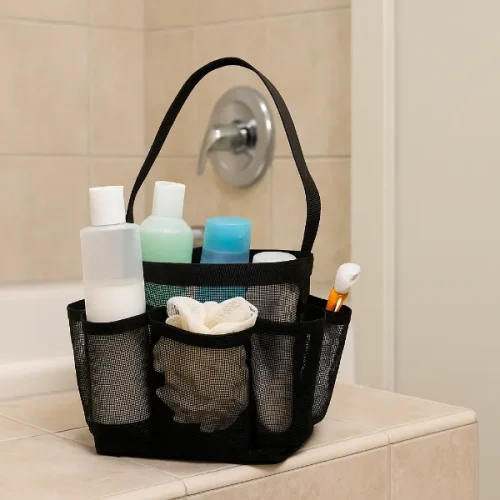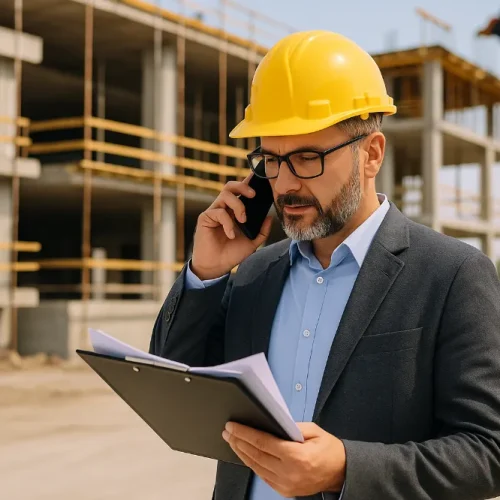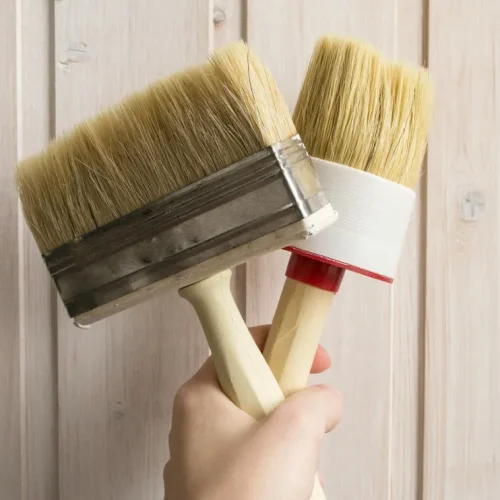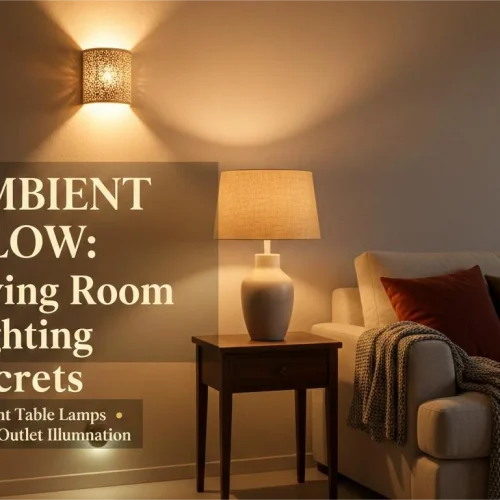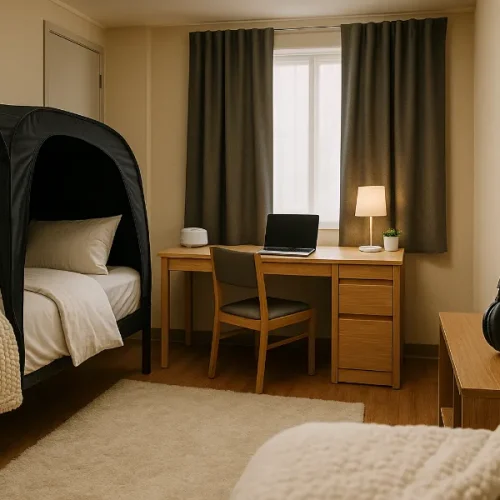
Outdoor spaces are no longer just patios and backyards; they have become living extensions of the home. These spaces hold morning coffees, evening conversations, weekend gatherings, and quiet afternoons spent reading in the shade. To make them feel like true living environments, homeowners and designers are turning toward contemporary outdoor furniture that balances style, comfort, and resilience.
One of the most important decisions in creating a stylish and long-lasting outdoor space is choosing the right furniture materials. The right materials determine how well pieces handle weather, how easy they are to maintain, how comfortable they feel, and how well they contribute to the overall aesthetic. Today’s market offers a wide spectrum of materials—from sleek metals to natural wood to performance fabrics—all engineered to perform beautifully outdoors.
This guide breaks down the most popular contemporary outdoor furniture materials, explaining their strengths, challenges, and ideal applications so you can make informed, confident choices.
Why Material Choice Matters
Outdoor furniture faces environmental conditions that indoor furniture never encounters. Rain, sun exposure, humidity, wind, and fluctuating temperatures all contribute to wear. The goal is to select materials that not only resist these conditions but also align with your design preferences and maintenance comfort level.
A few key factors influence material choice:
- Climate: Coastal environments require corrosion-resistant materials; dry regions benefit from UV-resistant surfaces.
- Usage: High-traffic or family-focused spaces need durable, low-maintenance options.
- Maintenance Preferences: Some materials age gracefully; others require periodic sealing or treatment.
- Style Vision: Minimalist, rustic, tropical, industrial, or luxury aesthetics all align best with different materials.
1. Powder-Coated Aluminum
Aluminum is one of the most popular materials in contemporary outdoor furniture because it blends modern aesthetics with practical durability. On its own, aluminum resists rust, but powder coating enhances its weather resistance and opens up endless color and texture options.
Advantages:
- Lightweight and easy to move.
- Rust-proof and ideal for humid climates.
- Sleek, clean-lined modern appearance.
Considerations:
- Can heat up in direct sun.
- Lightweight nature means wind can shift pieces.
2. Stainless Steel
For a bold, architectural look, stainless steel offers strength and visual presence. It is heavier and more structured than aluminum, giving furniture a luxury, high-end feel.
Advantages:
- Exceptional structural strength.
- Sophisticated modern finishes.
- Highly durable when using 304 or 316-grade stainless steel.
Considerations:
- Can get hot in the sun.
- Higher cost.
- Marine-grade steel needed near ocean environments.
3. Teak Wood
Teak has long been considered the premium material for outdoor furniture. Historically used in shipbuilding, it naturally resists moisture and insects due to its high oil content.
Advantages:
- Extremely durable and long-lasting.
- Warm, natural look that complements a range of aesthetics.
- Ages into a tasteful silver patina if left untreated.
Considerations:
- Higher cost than most woods.
- Requires maintenance depending on desired color retention.
- Look for sustainably harvested teak to ensure responsible sourcing.
4. Acacia and Other Hardwoods
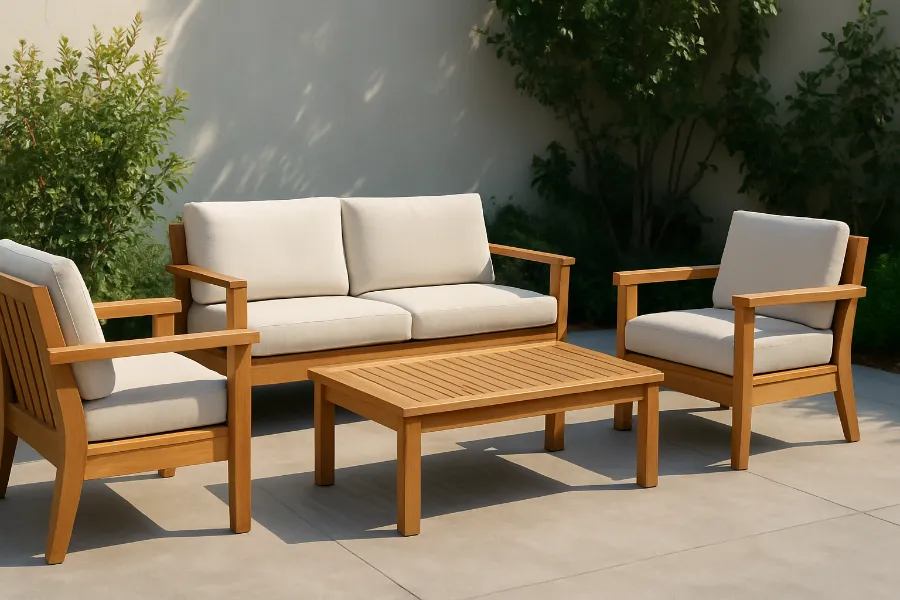
Acacia is a more affordable hardwood alternative that still provides warmth and natural beauty. Other woods, like eucalyptus, offer similar benefits.
Advantages:
- Affordable and stylish wood option.
- Rich grain patterns enhance outdoor warmth and intimacy.
Considerations:
- Requires regular sealing.
- Less durable than teak in extremely wet climates.
5. Synthetic Wicker (Resin Wicker or HDPE Wicker)
Modern synthetic wicker is engineered for longevity. High-density polyethylene (HDPE) wicker outperforms older PVC wicker in durability and UV resistance.
Advantages:
- Weather-resistant and long-lasting.
- Lightweight and easy to rearrange.
- Soft, inviting look that works in relaxed outdoor spaces.
Considerations:
- Avoid low-quality PVC wicker varieties.
- The frame beneath the wicker matters (aluminum frames last longest).
6. Woven Rope and Cord
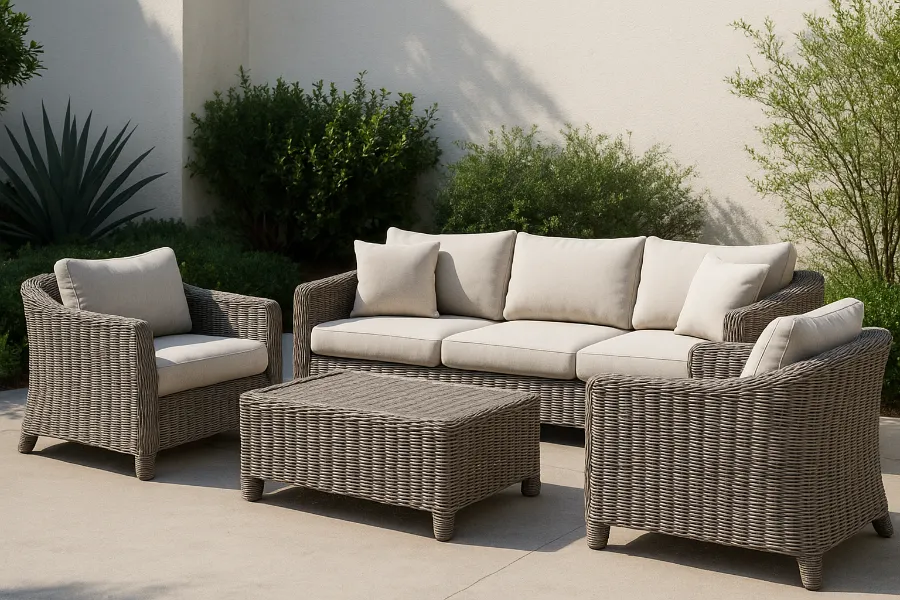
Rope outdoor furniture has gained popularity for its look and comfort. Designers use polyester, polypropylene, or marine-grade rope designed for UV and moisture resistance.
Advantages:
- Adds texture and softness to outdoor designs.
- Comfortable support without heavy cushions.
- Quick-drying and suitable for poolside environments.
Considerations:
- Low-quality rope may fray over time.
- Needs periodic cleaning to prevent buildup in the weave.
7. Concrete and Fiber Cement
Concrete furniture offers sculptural, modern presence. It pairs well with wood or metal for a balanced visual effect.
Advantages:
- Strong architectural styling.
- Extremely durable material form.
- Visually grounding in open outdoor spaces.
Considerations:
- Heavy and difficult to move.
- Requires sealing to prevent surface stains.
- Can feel cold or rigid without cushion accents.
8. Recycled Plastics and Polymer Lumber
Recycled plastic furniture offers a sustainable, low-maintenance choice often made from post-consumer materials like milk jugs.
Advantages:
- Environmentally responsible.
- Resistant to fading, cracking, and rot.
- Very low maintenance.
Considerations:
- May lack natural grain variation.
- Some styles may appear casual depending on brand.
9. Outdoor Performance Fabrics
Performance fabrics such as Sunbrella and Olefin are engineered for outdoor use.
Advantages:
- UV, mold, and mildew resistant.
- Comfortable feel similar to indoor textiles.
- Stain resistant and easy to clean.
Considerations:
- Higher initial cost.
- Periodic cleaning helps maintain texture and appearance.
Balancing Materials for Style
Some of the most compelling outdoor furniture today mixes materials:
- Teak with aluminum creates warmth against clean-lined structure.
- Rope woven onto steel frames adds texture to strong modern shapes.
- Concrete dining tables paired with soft fabric cushions create balance.
Mixing materials allows outdoor spaces to feel layered and intentional, much like indoor living rooms.
Maintenance Tips
- Use covers during bad weather or long non-use periods.
- Clean regularly to prevent buildup of dust, pollen, and salt.
- Store cushions during winter or heavy rain seasons.
- Seal natural woods if maintenance of original color is preferred.
- Keep furniture feet protected to avoid scratching patio surfaces.
Creating a Contemporary Outdoor Sanctuary
The best outdoor spaces feel welcoming, stylish, and personal. Choosing the right materials ensures the space remains functional and visually appealing through every season. Whether you prefer minimalist modern lines, coastal warmth, or an earthy, organic feel, contemporary outdoor furniture materials offer options that elevate both comfort and design.
Outdoor living has become an essential way to connect with the environment, relax more intentionally, and expand the beauty of home life. With the right materials in place, your outdoor space can feel like a natural continuation of your interior—one that invites pause, conversation, and enjoyment.
FAQs
Contemporary outdoor furniture typically features clean lines, modern materials, and a minimalist aesthetic compared to traditional styles.
Yes, teak remains one of the most durable and weather-resistant woods due to its natural oils that repel moisture and insects.
With proper care, powder-coated aluminum furniture can last many years because it resists rust, fading, and corrosion.
High-quality recycled HDPE plastic furniture is extremely durable, fade-resistant, and low-maintenance, making it ideal for outdoor environments.
Outdoor performance fabrics resist UV damage, mold, and stains, keeping cushions looking fresh longer.
High-grade stainless steel (304 or 316) is highly resistant to rust, but lower grades may corrode in salty or humid climates.
Most hardwoods benefit from sealing once or twice a year, depending on climate and how much sun exposure they receive.
Yes, synthetic wicker like HDPE is weatherproof and UV-resistant, while natural wicker deteriorates quickly outdoors.
Yes, but sealing is recommended to prevent moisture penetration and staining, especially in freeze-thaw climates.
Powder-coated aluminum, HDPE plastic, marine-grade stainless steel, and performance fabrics perform best near salt air.



